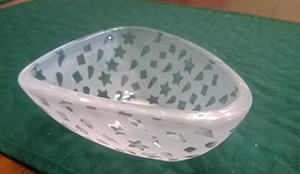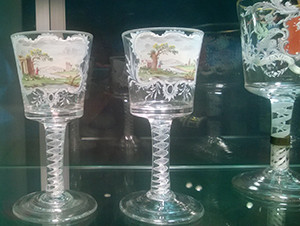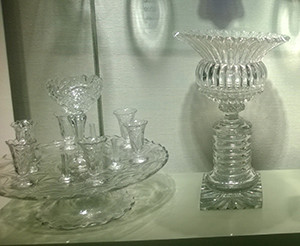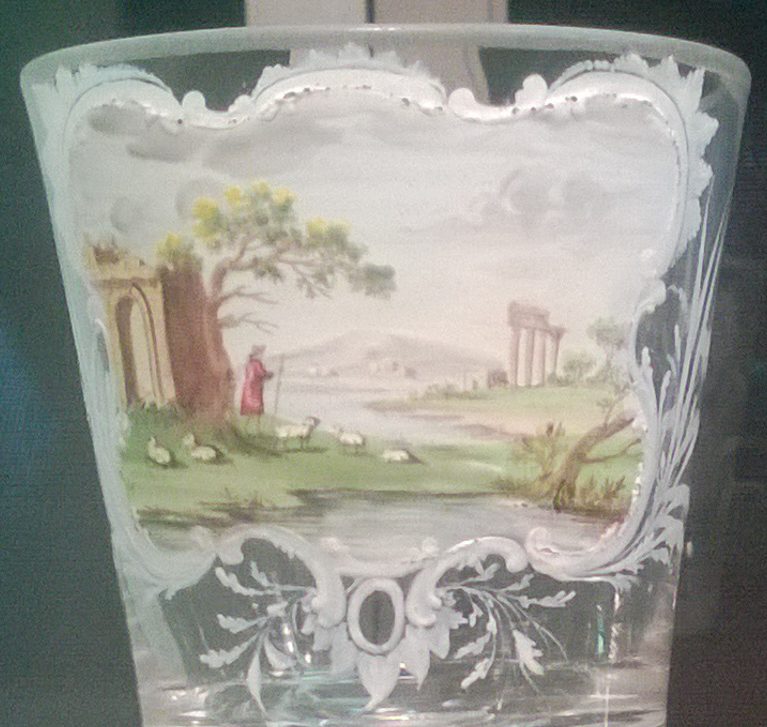In The Artist’s Way, Julia Cameron recommends taking a weekly Artist Date: a no pressure, fun outing or activity that pleases your inner artist. The Corning Museum of Glass is one of my favorite Artist Date destinations. Recently I took my daughter and some of her friends there for her birthday celebration and was able to take some time for myself in the galleries and the studio.
 For anyone who hasn’t visited CMOG, there’s a science section and a history section, where you can see everything from ancient Egyptian and Roman glass to Tiffany to modern art. There are some examples of Georgian and Regency glass—I’ll get to those later. There are contemporary glass art galleries—a whole new section was recently added. You can also watch a glass blowing demo or make your own project at their studios. Here’s a candy dish I made during this last visit.
For anyone who hasn’t visited CMOG, there’s a science section and a history section, where you can see everything from ancient Egyptian and Roman glass to Tiffany to modern art. There are some examples of Georgian and Regency glass—I’ll get to those later. There are contemporary glass art galleries—a whole new section was recently added. You can also watch a glass blowing demo or make your own project at their studios. Here’s a candy dish I made during this last visit.
 Rounding out this plug for CMOG, I’ll say that the café is excellent and the gift shop is full of beautiful things. I especially love the jewelry. There are trinkets to suit different budgets, from this dichroic glass pendant I got on sale for $5, to more expensive, one-of-a-kind items from master glass artists. (And there are good post-holiday sales…)
Rounding out this plug for CMOG, I’ll say that the café is excellent and the gift shop is full of beautiful things. I especially love the jewelry. There are trinkets to suit different budgets, from this dichroic glass pendant I got on sale for $5, to more expensive, one-of-a-kind items from master glass artists. (And there are good post-holiday sales…)
Here are some of the Georgian and Regency items I enjoyed during this last visit.
 The lovely enamel work on these glasses caught my eye. According to the label,
The lovely enamel work on these glasses caught my eye. According to the label,
“The Beilby family painted much of the colorless enameled glass that was made in England during and after the 1760s. William Beilby (1740-1819) and his sister Mary (1749-1797) enameled glasses with floral motifs, landscapes, and pictures of architectural ruins. The most famous of their glasses are goblets bearing the royal coats of arms. These goblets mark the birth of the Prince of Wales (later King George IV) in 1762.
Here’s a closeup that better shows the beauty of the enamel-work.
 I love the color and the detailing on this item, labeled merely “Casket: Birmingham or London, 1760-1770”. I could see one of my heroines using it to store her jewelry.
I love the color and the detailing on this item, labeled merely “Casket: Birmingham or London, 1760-1770”. I could see one of my heroines using it to store her jewelry.
 And here are some items I could see gracing a Regency dining table: “Dessert Stand: England, about 1715-80. This set consists of a revolving stand, jelly glasses, flower vases, and a central sweetmeat glass.” and “Pineapple Stand: England about 1830. This cut crystal stand was used to display pineapples, which were an exotic, highly prized status symbol in 19th century England.”
And here are some items I could see gracing a Regency dining table: “Dessert Stand: England, about 1715-80. This set consists of a revolving stand, jelly glasses, flower vases, and a central sweetmeat glass.” and “Pineapple Stand: England about 1830. This cut crystal stand was used to display pineapples, which were an exotic, highly prized status symbol in 19th century England.”
They rotate items around, which is one of the reasons I like to go to CMOG at least once a year. I highly recommend it!
Do you have favorite museums or places you like to go for “Artist Dates”?
Elena


Oh wow! Those enamelled glasses are beautiful! And the museum sounds just lovely.
One of my favorite museums is the Pitt Rivers Museum in Oxford (in order to access it, you have to walk through the Museum of Natural History, then step through a small door at the back – and a treasure trove of curiosities opens up in front of you!). It’s where I learned the word “slug” back in 1998, when I first visited Oxford (there’s a jar with a slug on a thorn – by now the slug is kind of white-ish, so you can’t really tell what it once was). And one of my favorite exhibits there is what I call “the molten toad”: the label (and they still have the original handwritten labels!) reads something like, “Object said to be a toad, stuck with nails and thorns for witchcraft purposes.” 🙂
Here’s the toad’s entry in the Pitt Rivers online database: http://objects.prm.ox.ac.uk/pages/PRMUID110697.html
And here’s a link to an article about the slug on a thorn: http://england.prm.ox.ac.uk/englishness-slug-on-a-thorn.html
LOL Sandy! I post pretty pictures of glass, and you post…well, people should go check out those links.
I find it interesting that in the cure for warts, you have to SECRETLY rub the slug on the wart. I guess I would prefer not to watch anyone doing it!
From what I remember from a long-ago folklore class on folk medicine, slug slime actually helps against warts (slug-killing not required). And you already know I’m weird. 😉
And please note that I refrained from mentioning the flying lion penis (with pretty bells!) that I sketched when I visited the British Museum in September. 🙂
Elena, what lovely things! The dish you made is very nice. I love museums –almost any kind, actually, but one of my favs is the Boston Museum of Fine Arts, well, partly because it’s nearer to me than say, the Met in New York. But I also love the Peabody Museum up in Salem, and another fav is the Museum of British Art at Yale in New Haven. They have a great collection of Regency-era portraits, and also a whole section of paintings by Turner. Oh, dear, I think I need to go there again soon!
I love the MFA in Boston. Must hit the other ones sometime!
Thank you for sharing your trip to the CMG with us. What fascinating objects – so delicate and beautiful.
When I lived in England the British Museum was my favorite haunt. I went up to London for piano lessons a few times a week and I always made time to spend an hour or so in the British Museum.
When I lived in Germany and studied in Salzburg I haunted the Mozart’s birthplace museum. Any time I was feeling down or uncertain I would spend time in the house where he was born and it always made me feel better.
The Rijksmuseum and the Van Gogh Museums were my favorites any time we were singing in or visiting Amsterdam.
Here in LA (Lower Alabama) museums are rather “thin on the ground.”
I visited the Discovery Museum the first year I attended an RWA Conference in NYC. The Pompeii Exhibit was there and it was incredible. Pompeii is on my bucket list of places to visit in person. This exhibit was the next best thing.
I’ve been to the Rijksmuseum but the others are on my list to see someday. A good way to plan vacations. 🙂